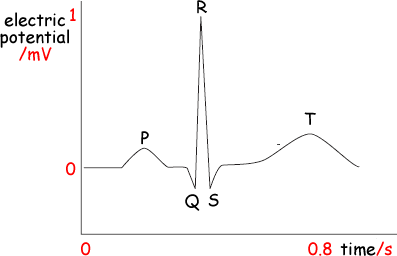'A' Level Medical Option Questions - The Heart - ECG
Q7.
(a) The diagram shows the ECG waveform produced when electrodes are attached to the chest of a healthy person. Label the axes with suitable scales and units.

Y axis - mV - range of 0 to 1 
X axis - seconds - - roughly 0.8s for a heartbeat (about 70 to 80 for a normal person per minute) 
(2 marks)
(b) State what is meant by depolarisation and repolarisation and, in terms of ion movement, explain how each effect is caused.
Depolarization (change of voltage from a negative to positive value ) is due to the opening of Na+ channels causing a rapid increase in the membrane conductance to Na+ and thus a rapid influx of Na+ ions into the cell; a Na+ current.
) is due to the opening of Na+ channels causing a rapid increase in the membrane conductance to Na+ and thus a rapid influx of Na+ ions into the cell; a Na+ current.
Repolarization (change of voltage from a positive back to a negative value ) - the sodium channels close, while the K+ channels are open. This ensures a net outward current, corresponding to a negative change in membrane potential.
) - the sodium channels close, while the K+ channels are open. This ensures a net outward current, corresponding to a negative change in membrane potential. (3 max)
(3 max)
(3 marks)
(c) State how the action of the atria and ventricles correspond to the waveform PQRST shown in the diagram
Atrial contractions shows up as the P wave. 
Ventricular contractions show as a series known as the QRS complex. 
The T wave is the electrical activity produced when the ventricles are recharging for the next contraction (repolarizing). 
(3 marks)
(Total 8 marks)


